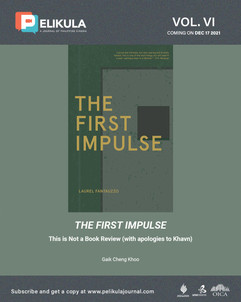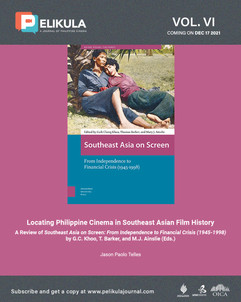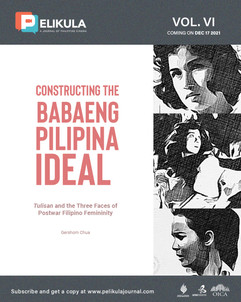Patrick Campos: Vanguard Of Philippine Cinema Narratives
- The Film Dream

- Dec 17, 2021
- 8 min read

Have you ever felt like you wanted to visit a place but got entangled in the fact that you don’t know where to start because there’s no existing trail or even map of it?
This is how Patrick Campos, a Filipino film scholar, educator, programmer, and critic, describes what film researchers like him go through that made him reignite Pelikula: A Journal of Philippine Cinema.
“N’ong una akong naging mananaliksik at mag-aaral ng pelikula... ang hirap talaga. Ang gagawin ko, pupunta ako sa libraries, sa periodical archives, sa microfilms… talagang maghapon na tinitingnan ko ang bawat pahina. It’s difficult. There are so few resources, so many lost films.”
Pelikula: A Journal of Philippine Cinema is a textual and visual repository of undocumented or new accounts of our cinema, the activities of film enthusiasts and film workers, and the societal issues affecting our film culture and industry. After twenty years, Pelikula returned from its first publication in 1999 under Nicanor Tiongson’s editorship.
Patrick, who also served as Director of the University of the Philippines Film Institute from 2018 to 2020, revived the journal as one of the series of activities during the celebration of the Centennial Years of Philippine Cinema and the commemoration of Jose Nepomuceno’s Dalagang Bukid.
But, what made Patrick trek an unsure road even if there’s so much struggle and backlog?

“Film major ako sa UP. In the beginning, I thought I’d be a filmmaker. Celluloid pa no’n, hindi pa digital. The context then was very different. I did work in the industry, but I felt that the industrial context was problematic. Hanggang ngayon naman, we still know that the working conditions are far from ideal, and I couldn’t stomach that.”
After a stint in the industry, Patrick returned to school and pursued a master’s in literature. While studying, he thought that the best thing to complement doing research was to teach at the same time. He eventually fell in love with teaching.
“Little did I know that I was mentoring students who would eventually introduce many changes in the industry, to Philippine cinema in general. Wala pa sa hinagap ko na magiging gano’n kalaki at kahusay ang mga achievements nila. Many of them were, are, at the forefront, then and now, and they sat in my classes. Nakakataba ng puso when some of them would look back and say, ‘yong time nila as my student ang nag-inspire sa kanila na i-pursue ang paggawa ng pelikula, o tingnan ang pelikula, in a certain way. So, when I sometimes wonder why I do what I do, I would remember that.”
For him, these students who have become catalysts of change aren’t his trophies but humbling reminders to pursue his dream of preserving the historical journey of Philippine cinema.
We asked him if he was challenged by the consequences of the pandemic in teaching film.
“May silver lining itong pandemic because in my years of being a researcher of Southeast Asian cinema and Philippine cinema, ngayon ko talaga naramdaman na napaka-intense ng connection ko, natin, with filmmakers and scholars from elsewhere and with each other, na dati hihintayin mo pa [ang] part ng taon [like festivals and conferences] para makita mo sila in person o makapanood ng mga bagong pelikula, say, from Cebu or Mindanao or Malaysia. While the situation is far from ideal, the past year was an opportunity to strengthen relationships with like-minded people even if they’re far away and to see new works that were previously hard or impossible to access. We are getting to know regional cinemas better today, I think. Regional sa loob at labas ng Pilipinas.”
From the pandemic’s frustrating limitations, the film industry learned to adapt. From exploring new platforms, curating online programs, and maximizing the use of the digital space, Patrick witnessed how the pandemic somehow also made industry sectors come together.
“It’s still difficult, but by force of circumstances, pinilit ng pandemic tayong mag-connect sa isa’t-isa, to look out for each other, to rethink what we’ve been doing wrong. Guilds, associations, networks are forming to address the times and age-old issues. I think ‘yan ang maganda. There’s no turning back. Magiging hybrid na ang mga bagay at the very least. And another silver lining is that young filmmakers will have an expanded platform, [which] will be open for them even after the pandemic.”
THE FILMMAKING INDUSTRY AMIDST PANDEMIC
It may look like politics are not directly an issue concerning the film industry, but he believes that filmmakers always occupy a political position and should evaluate their role in showing what needs to be known by the public, whether in their films or beyond.
“Kaya pa ba nating i-reverse ang political tides at may magagawa pa ba? Because whatever happens will affect all of us. We’ve witnessed how the freedom of the press, the freedom to express, have been threatened, and these have a chilling effect.” Patrick is also concerned with how filmmakers have allowed themselves to be used by powers that be and how certain films are becoming tools for priming and agenda-setting.
Of course, we can’t picture out the fact that films need to be promoted. Given that the pandemic limits the filmmaking industry to work the way it used to, he believes that the current conditions, though tough, allow us to discover tactics and ways to engage with the people continuously.
“Many things in this pandemic are beyond our power to change, but there are many more things that we can change. As days go by, tinuturuan tayo ng panahon ng mga paraan nang hindi natin namamalayan. Kailangan lang natin maging sensitive sa mga nangyayari. At magaling tayo d’yang mga Pinoy---mag-adapt. Maging sensitive tayo sa opportunities, sa threats. If we are open to adjusting and adapting, we can find ways to engage.”
Patrick shared with The Film Dream three things that need to be considered by filmmakers.
First, today’s filmmakers can now work toward making films wherever they are. They have the ability to tell stories, and it is the stories from their communities that must be told. Second, there are growing opportunities to collaborate beyond one’s own backyard, shores, borders. We will be seeing more cooperation between artists and researchers from different places, which is something to look forward to. And third, these new trends and opportunities are connected and must somehow look back to the glorious tradition and history of Philippine cinema as well as the histories of our Southeast Asian neighbors. The themes, stories, and genres that speak both to the times and to history and those that have a sense of “pakialam” with what’s happening remain important, according to him.
It’s astounding to witness how someone like Patrick Campos strives to preserve the value of Philippine cinema even if foreign influences incessantly emerge. His perseverance and vision are all vivid in the newly released volume of Pelikula Journal.

THE PELIKULA JOURNAL
The Pelikula Journal’s first release in print was in 1999, and the transition from celluloid to digital was documented in it. However, the first run was short-lived, and the last volume was published in 2001. Now that digital publication is possible, the editorial team of Pelikula Journal took advantage of new possibilities.
“Narealize ko na ang laki ng interest ng public sa kamalayan at pag-aaral ng pelikula. Ang mga Pinoy, ang lakas ng consciousness sa pelikula, sa music, sa sining. At first, madaling isipin na we might be esoteric, na baka walang ibang kausap ang journal. But it turns out, hindi naman pala, dahil marami talagang may interes... at doon masayang-masaya kami. The first two volumes have reached thousands of readers. Kaya malakas ang loob namin na we can continue because it appears that people appreciate and want to support what we are doing. And we really need the support, because how else can we continue?”
Who would have thought that after decades of Pelikula’s last release, there’ll be another effort to document Filipino film, its past and present developments?
As a media and information literacy advocate, Patrick aspires not only to help new works get published but also, hopefully, to make old books freely available in the digital world, accessible to the people in the industry and the academe. He just hopes there would be some support to turn these dreams into reality.
“A lot of funding from private and government agencies goes into film production and film festivals, which is very good. But resources also need to be poured into research, writing, publications, libraries, archives. Philippine cinema is not only about films today or the work of a few people. We owe the succeeding generations the means to remember, not just what happened with our films but with us as a people.”

Patrick understands well how knowing the Philippines’ social context is relevant to filmmaking. Being aware of it brings guidance to producing films that showcase important, even urgent, Filipino stories.
“Ang mahalaga, Pelikula Journal can be read by storytellers, students, researchers, pero puwede sa general audience na nais makilala 'yong film culture natin. Hindi tayo nagsimula o umiiral sa vacuum… so I think all storytellers should remember the bigger story of Philippine cinema. That’s really where the significance of the story comes in. The fact na alam mong may gumawa na nito dati. Na hindi tayo tempted just to look to other cultures all the time, which in a way [has become our] default, though there is nothing wrong with that, and we grow that way, but to look to our own achievements and struggles, too, and understand the particularities of our experience.”
Filmmaking in the local scene is very diverse, and Patrick hopes, through Pelikula Journal, to have a way of keeping an ongoing conversation with it. That’s why in the fourth volume of Pelikula Journal, they were able to celebrate the Centennial by surfacing forgotten stories and personalities. And in volume five, the filmmakers’ active participation in battling authoritarian tendencies in the government amidst pandemic was documented.
What a history, isn’t it?
“Whatever we feel should be discussed and whatever I feel na magandang ungkatin from an editorial perspective, that’s what we will write about [while carrying] the hope [for future filmmakers] na alam ‘yong context ng sariling [bayan at sining sa] paggawa ng pelikula.”
To someone who writes history, Patrick Campos still has a lot of dreams. He dreams of a library and an archive where researchers can access books, articles, digitized resources like scripts, and films, so we can write more and understand our cinema better and help it grow in the process. He dreams of creating a network of libraries and archives that will connect hubs od filmmaking and film studies across the Philippine islands and beyond to document the developments of cinemas in the regions and to foster a strong community.
These all might be too good to become true, but what’s wrong with dreaming?
For sure, a time will come that we’ll wake up accessing these materials and resources. And when that day comes, we’ll definitely thank Patrick Campos that he envisioned these for Philippine cinema.
But for now, the task at hand is to support and sustain Pelikula Journal.
“The vision for Pelikula remains the same---to be a space, a repository, for ideas, discussions, debates, and a kind of proxy for a library. Ang daming nangyayari sa film sector. Maraming films na nagagawa. Dumarami ang filmmakers at mga kuwento. At ang daming dapat talakayin. 100 years na ang cinema natin pero wala pa rin tayong sustained journal. This is what Pelikula’s all about---we want to fill this gap in Philippine cinema.”
Published by the UP Film Institute, with the support of the Japan Foundation, Manila, and the UP Diliman Office for Initiatives in Culture and the Arts, the sixth volume of Pelikula Journal is freely downloadable from the journal website: www.pelikulajournal.com.
Sign in as a site member here at thefilmdream.com and we will send you email updates.



















Comments